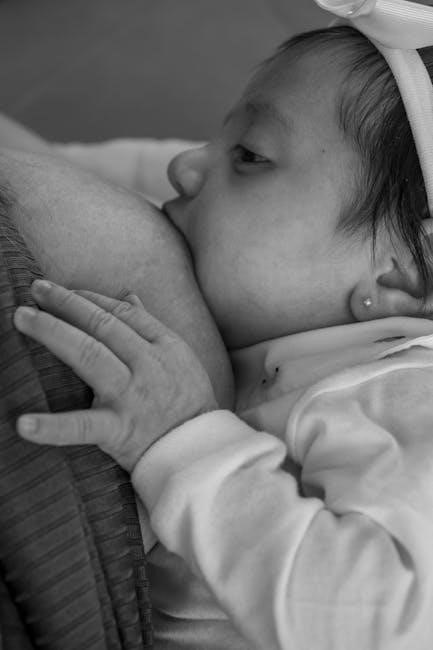Welcome to The Breast Archives Parents Guide, a comprehensive resource for educating children about breast health. This guide provides essential insights and accurate information to support parents in fostering open conversations about breast development, health, and wellness. Discover expert-backed knowledge to help your child navigate breast-related topics confidently.
Overview of The Breast Archives
The Breast Archives is a comprehensive resource designed to provide parents with accurate and age-appropriate information about breast health, development, and wellness. It addresses topics such as breast growth stages, common concerns, and lactation, offering expert-backed guidance. The archive aims to empower parents with knowledge to support their children in understanding breast health, fostering open conversations, and promoting overall wellness. By addressing both physical and emotional aspects, it serves as a trusted guide for navigating breast-related topics from adolescence through adulthood.

Importance of Breast Health Education for Parents
Breast health education is crucial for parents to guide their children effectively. It equips parents with the knowledge to address natural concerns, such as breast development and common issues, fostering open dialogue. Early education helps in promoting healthy habits, reducing myths, and encouraging timely medical consultations when needed. By understanding breast health, parents can support their children in maintaining physical and emotional well-being, preparing them for life’s changes confidently.

Understanding Breast Development and Health
Breast development is a natural process influenced by hormones during puberty. Understanding healthy growth patterns, common changes, and signs of potential issues is vital for lifelong well-being.
Normal Breast Development in Adolescents
Normal breast development in adolescents begins with hormonal changes during puberty, typically starting around age 10-11 for girls. Breasts develop in stages, beginning with budding and progressing to full maturity. Asymmetry is common, and most cases resolve naturally. Parents should reassure teens that variations in size and shape are normal. Monitoring for unusual changes, such as lumps or discharge, is essential. Open dialogue and professional guidance can help adolescents understand and navigate this natural process confidently. Early education fosters healthy attitudes toward body changes and long-term breast health.
Common Breast Concerns in Teenagers
Teenagers often experience concerns about breast asymmetry, tenderness, or changes in texture. Worries about breast size or shape are common, as are questions about discharge or lumps. While most issues are harmless, addressing them early can prevent anxiety. Open conversations with parents or healthcare providers are crucial. Reassurance and education help teens understand normal variations and differentiate between typical changes and signs of potential issues. Encouraging self-examination and fostering a positive body image are key to promoting long-term breast health and emotional well-being during adolescence.
The Role of Parents in Promoting Breast Health
Parents play a vital role in fostering healthy attitudes and practices regarding breast health. By creating an open and supportive environment, parents can encourage their children to ask questions and express concerns. Education about normal breast development and self-examination techniques empowers teens to take charge of their health. Addressing myths and providing accurate information helps alleviate fears. Parents should also promote positive body image and emphasize the importance of regular health check-ups. By modeling healthy habits and fostering trust, parents guide their children toward informed decisions and lifelong breast health awareness.

Breastfeeding and Lactation Guide for Parents
Welcome to this guide, designed to support parents with breastfeeding and lactation. Explore expert advice, common challenges, and essential resources to ensure a smooth and confident experience for both mother and baby.
Preparing for Breastfeeding
Preparing for breastfeeding involves education, physical readiness, and emotional support. Antenatal expressing can help collect colostrum for newborns. Consulting lactation specialists ensures a smooth start. Educate yourself on proper latching techniques and nipple care. Create a comfortable nursing environment and consider a breast pump for future use. Stay mentally prepared, as initial challenges are common. Building a support network and staying informed fosters confidence and success in your breastfeeding journey.
Common Challenges and Solutions
Breastfeeding can present challenges, such as latching difficulties, nipple soreness, or low milk supply. Solutions include consulting lactation specialists for personalized guidance; Using nipple shields or breast pumps can alleviate discomfort and express milk effectively. Stay hydrated, maintain a balanced diet, and rest to support milk production. Engage in skin-to-skin contact to enhance bonding and stimulate letdown reflex. Seek support from breastfeeding groups or online resources for tailored advice. Remember, challenges are temporary, and persistence, combined with the right strategies, can lead to a successful breastfeeding experience for both mother and baby.

Support Resources for Breastfeeding Mothers
Breastfeeding mothers can access numerous support resources to overcome challenges. Lactation consultants provide personalized guidance, while support groups offer community and shared experiences. Online forums and helplines, such as the National Breastfeeding Helpline, offer immediate assistance. Educational materials, including videos and guides, are available to address common concerns. Employers often provide lactation rooms and flexible schedules to support breastfeeding. Additionally, organizations like La Leche League and local breastfeeding coalitions offer workshops and one-on-one counseling. These resources empower mothers to navigate breastfeeding confidently, ensuring a positive experience for both mother and child.

Breast Health Monitoring and Self-Examination
Regular breast health monitoring and self-examination are crucial for early detection of changes. Learn proper self-exam techniques and understand the importance of professional screenings for maintaining optimal breast health.
How to Perform a Self-Examination
Performing a self-examination involves observing and feeling your breasts for changes. Stand in front of a mirror and look for symmetry, swelling, or skin changes. Raise your arms and check for dimpling or redness. Gently press your fingers into your breasts in a circular motion, feeling for lumps or tenderness. Pay attention to the nipple area and any discharge. Regular self-exams help detect early signs of breast health issues. Schedule annual clinical exams and mammograms as recommended by healthcare professionals to ensure comprehensive breast health monitoring.
When to Seek Medical Advice
Consult a healthcare professional immediately if you notice unusual changes, such as a lump, swelling, or dimpling in your breasts. Seek advice if you experience nipple discharge, redness, or pain that persists. Any changes in breast symmetry or skin texture should also be evaluated. If you find a lump during self-examination, schedule an appointment without delay. Regular screenings and check-ups are vital for early detection and peace of mind. Timely medical consultation ensures proper evaluation and addresses concerns promptly, promoting optimal breast health outcomes.
Understanding Breast Screening and Mammograms
A mammogram is a specialized X-ray examination of the breast used to detect abnormalities, such as tumors or calcifications, that may not be visible during a self-examination. Breast screening is a critical tool for early detection of breast cancer, often identifying issues before symptoms appear. Mammograms involve gentle compression of the breast to capture clear images. While they may cause temporary discomfort, the process is quick and essential for monitoring breast health. Regular screenings are recommended for women over 40, though guidelines vary. Early detection significantly improves treatment outcomes, making mammograms a vital part of proactive breast care.

Nutrition and Lifestyle for Breast Health
A balanced diet rich in fruits, vegetables, and lean proteins supports breast health. Regular exercise, limited alcohol, and avoiding smoking are key lifestyle choices to reduce breast cancer risk and promote overall well-being.

Dietary Recommendations for Breast Health
A well-balanced diet plays a crucial role in supporting breast health. Focus on consuming a variety of fruits, vegetables, and whole grains, which are rich in antioxidants and fiber. Incorporate lean proteins like poultry, fish, and legumes, while limiting processed meats. Healthy fats, such as those found in nuts, seeds, and olive oil, are also beneficial. Stay hydrated with water and limit sugary drinks. Avoid excessive alcohol and saturated fats, as they may increase breast cancer risk. A diet high in phytoestrogens, like soy and cruciferous vegetables, can also support hormonal balance. These choices help reduce breast cancer risk and promote overall well-being.
Exercise and Its Impact on Breast Health
Regular physical activity significantly benefits breast health by reducing breast cancer risk and promoting overall well-being. Exercise helps maintain a healthy weight, lowering estrogen levels that can contribute to breast cancer. It improves blood circulation, enhancing the body’s ability to fight off abnormalities. Additionally, physical activity reduces inflammation, a known risk factor for chronic diseases, including breast cancer. Aim for at least 150 minutes of moderate-intensity aerobic exercise, such as brisk walking or cycling, weekly. Strength training twice a week can further enhance benefits. Consistency is key, as even small amounts of exercise can make a meaningful difference in breast health.
Managing Stress for Optimal Breast Health
Chronic stress can negatively impact breast health by altering hormone levels, including cortisol and estrogen, which may increase breast cancer risk. Engaging in stress-reducing activities like meditation, yoga, or deep breathing exercises can help mitigate these effects. Prioritizing mindfulness and self-care practices fosters emotional well-being, which is essential for maintaining optimal breast health. Encourage creating a calming environment and seeking professional support when needed to manage stress effectively. A balanced lifestyle, including relaxation techniques, can contribute to overall health and reduce risks associated with prolonged stress.

Addressing Common Concerns and Myths
Common myths about breast health often cause confusion and unnecessary fear. Understanding factual information helps dispel misconceptions, such as the belief that small breasts are healthier or that bras cause cancer. Education and open conversations are key to addressing these concerns and promoting accurate knowledge.
Debunking Common Myths About Breast Health
Common myths about breast health often lead to confusion and fear. For instance, many believe small breasts are healthier, but size doesn’t determine health risks. Another myth is that wearing bras causes cancer, which is unsupported by evidence. Additionally, breastfeeding does not ruin breast shape—it naturally changes due to pregnancy and aging. Understanding these facts helps reduce anxiety and promotes accurate knowledge. By addressing such misconceptions, parents can guide their children with confidence and ensure they have a clear understanding of breast health. Accurate information is key to fostering a healthy and informed mindset.
Addressing Body Image Issues in Adolescents
Adolescents often face body image concerns due to societal pressures and developmental changes. Parents play a vital role in fostering a positive self-image by encouraging self-acceptance and resilience. Open conversations about diversity in body types and the natural changes during puberty can help reduce anxiety. Avoiding criticisms and modeling positive body acceptance are key. Encourage focusing on health rather than appearance and promote media literacy to critically evaluate unrealistic beauty standards. By providing emotional support and factual information, parents can help adolescents develop a healthy and confident relationship with their bodies during this sensitive phase of growth.
Understanding Breast Cancer Risks and Prevention
Understanding breast cancer risks and prevention is crucial for empowering parents and adolescents with knowledge. Early education on breast health can reduce fears and promote proactive care. Encourage regular self-examinations and highlight the importance of a healthy lifestyle, including balanced diets and exercise. Discuss the role of genetics and family history in assessing personal risk. Emphasize the significance of regular screenings and mammograms for early detection. Foster open conversations about breast changes and the importance of seeking medical advice promptly. By addressing myths and providing factual information, parents can help adolescents develop a informed approach to breast health and cancer prevention.

Legal and Workplace Considerations for Breastfeeding
Navigate legal rights and workplace accommodations for breastfeeding mothers. Understand protections under the law and employer obligations to support nursing employees. Advocate for inclusive policies fostering a breastfeeding-friendly environment.
Workplace Accommodations for Breastfeeding Mothers
Employers are required to provide breastfeeding mothers with private spaces for expressing milk and storage solutions. Under federal and state laws, workplaces must accommodate nursing employees by offering break times and shielded areas. These accommodations ensure mothers can continue breastfeeding without workplace barriers. Employers must also provide access to refrigeration for storing breastmilk. Creating a breastfeeding-friendly environment fosters productivity and employee well-being. Understanding these legal obligations helps employers support nursing mothers effectively while complying with workplace lactation policies.
Legal Rights and Protections for Nursing Mothers
Nursing mothers are protected under the Affordable Care Act and the Break Time for Nursing Mothers law. Employers must provide reasonable break time and a private space for expressing milk. Discrimination based on breastfeeding is illegal under federal and state laws. These protections apply to all employees, including part-time and hourly workers. Violations can result in legal action. Additionally, many states offer expanded protections, ensuring workplace accommodations and privacy for nursing mothers. Understanding these rights empowers mothers to advocate for themselves while balancing work and breastfeeding responsibilities effectively.
Advocating for Breastfeeding-Friendly Policies
Advocating for breastfeeding-friendly policies involves promoting supportive environments for nursing mothers. Parents and communities can raise awareness about the importance of accommodations, such as private spaces and flexible work arrangements. Engaging with policymakers and employers to implement breastfeeding-friendly practices is crucial. Education and outreach efforts can help normalize breastfeeding and reduce stigma. By fostering collaboration between stakeholders, we can create inclusive policies that empower mothers to breastfeed confidently. Advocacy also includes supporting legislation that protects breastfeeding rights and ensures equitable access to resources for all nursing mothers.
The Breast Archives Parents Guide offers a comprehensive approach to breast health education, empowering parents with knowledge and fostering open, supportive conversations about breast development and wellness.
Summarizing Key Takeaways
The Breast Archives Parents Guide emphasizes the importance of education, open communication, and proactive breast health monitoring. Parents play a vital role in fostering awareness and supporting their children through breast development and beyond. Key takeaways include understanding normal breast development, addressing common concerns, and promoting healthy lifestyles. Encouraging self-examination, balanced nutrition, and stress management are essential for long-term breast health. Additionally, staying informed about breastfeeding, legal protections, and resources for support can empower families to make informed decisions. By fostering open conversations, parents can help their children navigate breast health confidently and responsibly.
Encouraging Open Conversations About Breast Health
Fostering open conversations about breast health is crucial for building trust and awareness. Parents should create a safe, judgment-free environment where children feel comfortable asking questions. Using age-appropriate language and addressing myths can help demystify breast-related topics. Encourage curiosity and provide accurate information about breast development, health, and wellness. By normalizing these discussions, parents can empower their children to take an active role in their health. Open dialogue also strengthens parent-child relationships and equips young individuals with the knowledge they need to make informed decisions about their bodies. Regular, heartfelt conversations can lead to healthier attitudes and habits.
Final Recommendations for Parents
To support your child’s breast health, prioritize education and open communication. Stay informed about breast development and wellness to address questions accurately. Encourage self-examination and regular health check-ups. Foster a supportive environment where your child feels safe discussing concerns. Lead by example, promoting positive body image and healthy habits. Advocate for age-appropriate resources and professional guidance when needed. By taking these steps, you empower your child to embrace their health confidently and responsibly.
